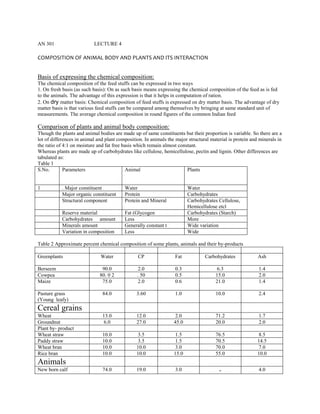
An 301 lecture 4 animal & plant composition
- 1. AN 301 LECTURE 4 COMPOSITION OF ANIMAL BODY AND PLANTS AND ITS INTERACTION Basis of expressing the chemical composition: The chemical composition of the feed stuffs can be expressed in two ways 1. On fresh basis (as such basis): On as such basis means expressing the chemical composition of the feed as is fed to the animals. The advantage of this expression is that it helps in computation of ration. 2. On dry matter basis: Chemical composition of feed stuffs is expressed on dry matter basis. The advantage of dry matter basis is that various feed stuffs can be compared among themselves by bringing at same standard unit of measurements. The average chemical composition in round figures of the common Indian feed Comparison of plants and animal body composition: Though the plants and animal bodies are made up of same constituents but their proportion is variable. So there are a lot of differences in animal and plant composition. In animals the major structural material is protein and minerals in the ratio of 4:1 on moisture and fat free basis which remain almost constant. Whereas plants are made up of carbohydrates like cellulose, hemicellulose, pectin and lignin. Other differences are tabulated as: Table 1 S.No. Parameters Animal Plants 1 . Major constituent Major organic constituent Structural component Water Protein Protein and Mineral Reserve material Carbohydrates amount Minerals amount Variation in composition Water Carbohydrates Carbohydrates Cellulose, Hemicellulose etcl Carbohydrates (Starch) More Wide variation Wide Fat (Glycogen Less Generally constant t Less Table 2 Approximate percent chemical composition of some plants, animals and their by-products Greenplants Water CP Fat Carbohydrates Ash Berseem Cowpea Maize 90.0 80. 0 2 75.0 2.0 . 50 2.0 0.3 0.5 0.6 6.3 15.0 21.0 1.4 2.0 1.4 84.0 3.60 1.0 10.0 2.4 13.0 6.0 12.0 27.0 2.0 45.0 71.2 20.0 1.7 2.0 10.0 10.0 10.0 10.0 3.5 3.5 10.0 10.0 1.5 1.5 3.0 15.0 76.5 70.5 70.0 55.0 8.5 14.5 7.0 10.0 74.0 19.0 3.0 - 4.0 Pasture grass (Young leafy) Cereal grains Wheat Groundnut Plant by- product Wheat straw Paddy straw Wheat bran Rice bran Animals New born calf
- 2. Dairy cow Sheep Hen 57.0 74.0 57.0 17.0 16.0 21.0 21.6 5.0 19.0 82.0 72.0 87.0 16.4 21.4 3.5 0.6 4.5 4.0 5.0 4.4 3.0 - Animal by-product Blood Muscles Milk 0.1 0.6 4.7 0.7 1.5 0.8 Factors affecting chemical composition of plants: The chemical composition of plants depends very much upon their growth. The following factors affect the plant composition: 1. Plant factor: There is a marked difference in the chemical composition between the different varieties of the same species of forage because of different genetic material. 2. Agro-climatic condition: When a forage plant is exposed to variable agro-climatic conditions it shows variable growth performance, which directly reflects the chemical composition. The factors like atmospheric temperature and humidity affect the chemical composition of plants. 3. Cultivation practices: The cultivated forages, under the same agro-climatic conditions perform in different ways depending on the cultivation practices. The seed rate, seed treatment, time of sowing, method of sowing, manure and fertilizer, irrigation, weeds and disease control measures not only influence the growth and yield of the forages but also chemical composition. 4. Stage of growth: There is a relationship between the stage of growth of the plants and its chemical composition. The content of crude protein, soluble ash, phosphorus and potash is higher just before flowering and goes down at bloom and seed formation stage whereas, crude fibre and dry matter content increase as the plant matures. Ether extract goes down with the progressive maturity of the plant. 5. Processing and preservation practices: The changes in chemical composition of plants are very much influenced by method of processing and preservation. Different processing methods may change particle size, particle shape, nutrient contents and also composition of plant materials. Biochemical basis of soil, plant and animal: A close inter-relationship The plant synthesized their feed from CO2 and H20 in the presence of sunlight and chlorophyll in the form of carbohydrates, which is structural as well as storage component of plants. They absorb minerals (Inorganic component) as well as water from soil and precede various biochemical reactions in plant body. Many factors like application of manures and fertilizers, irrigation, stage of growth, frequency of cutting, type of variety and strain and soil composition affect the chemical composition of the plant. As the composition of soil changes, it also affects composition of plants. Similarly, animals utilize the plants and plant by products as their food. So composition of plants and soil also reflected into animal body composition. When plants and animals died, they are mixed into soil as a decaying organic material or as inorganic material when these are burnt. Animals also nourished the soil by their faeces, urine and other excretion and wasteproducts. Similarly plants dropped their dried leaf and fruits on the soil. So plant and animals affect the chemical composition of soil and the soil also have the same function. So there is a close inter-relationship between plants, animals and soil. And they are closely interrelated with each other. This indicates the biochemical basis of soil, plant and animals.
